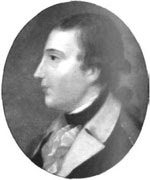
Brigadier General Richard Montgomery (1738-75) was the third son of an Irish MP. Educated at Trinity College, Dublin, he became an ensign in the 17th Foot at 18 and in 1757 went to North America, serving at Louisburg, Ticonderoga, Crown Point, and Montreal. By 1760 he was adjutant of his regiment; he served at the capture of Martinique and Havanna in 1762, and ended the Seven Years War as a captain. After the Treaty of Paris, he remained in New York for two years, before returning to England in 1765, where he met prominent Whigs, such as Edmund Burke and Charles Fox.
By the early 1770s, Montgomery was disenchanted with the poor prospects of a peacetime army officer. In 1772, he sold his commission (having lost a chance to buy a majority in controversial circumstances) and emigrated to North America, buying a farm at King's Bridge, New York. In 1773, he married the daughter of prominent local landowner and judge Robert Livingston. This family connection opened doors and despite being resident in the Colonies for barely three years, Montgomery was appointed to represent Dutchess County at the New York Provincial Congress. In June 1775, the Provincial Congress nominated him for the post of brigadier general in the Continental Army. In both cases, his name was put forward without his knowledge and he only agreed to serve out of a sense of duty towards a community that had welcomed and befriended him.
Two months later, Montgomery found himself second-in-command of the Separate Army. Following Schuyler's withdrawal through illness, it was left to Montgomery to lead the inexperienced and undisciplined force into Canada. That leadership was enough to bring success at St Johns, but even he could not prevent his men leaving as their enlistments expired. His bravery eventually cost him his life at Quebec; when the British identified his corpse, it was buried with decency inside the walls of Quebec City.
Prior to his death, Montgomery had been promoted to the rank of major general, but was unaware of it when he led the assault on 31 December. He thus became the most senior Continental officer to be killed in action (Warren, killed at Bunker Hill, had been appointed a major general, but did not receive his commission). After Montgomery's death, he became the subject of Revolutionary verse and prose (including one work attributed to Thomas Paine), extolling his virtue and heroism -somewhat ironic given his reluctance to serve, either politically or mili¬ tarily. His fate was also used to argue for extending periods of enlistment beyond one year. In 1787, a monument (made in Paris at the order of Benjamin Franklin) was erected in St Paul's church in New York City. In 1818, his body was exhumed, brought south and interred in the same church.